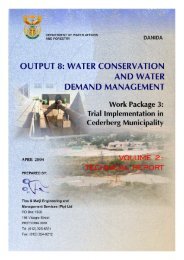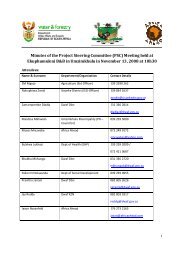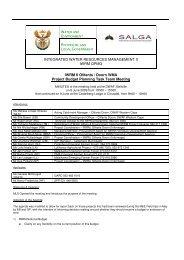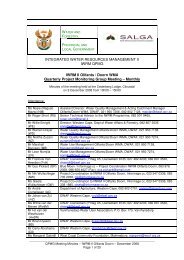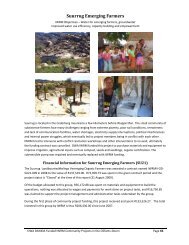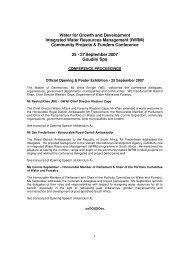You also want an ePaper? Increase the reach of your titles
YUMPU automatically turns print PDFs into web optimized ePapers that Google loves.
FLIPCHART 2: Caring for shared facilities<br />
Message: Respect for resources and shared resources<br />
Notes to facilitator<br />
1. Ask participants to look at the flipchart showing the women’s toilets at an Education Centre. Ask them the following<br />
questions:<br />
a. What is happening in this picture<br />
b. Has something like this ever happened to you<br />
c. How did you feel about it Why<br />
d. How would you feel about having to use a toilet like this Why<br />
e. Do you think there is a difference between stealing toilet paper and stealing or breaking a door<br />
f. If we don’t want toilets like this, what can we do to stop this situation from happening<br />
g. Why do you think the toilet is blocked and overflowing<br />
h. Do you think people can get sick from toilets in this condition Why<br />
Possible answers:<br />
a. There are three toilets, and a long queue of women is waiting to use them. Two of the toilets cannot be used as one has no door and a broken<br />
seat and the other is out of order. The toilet in the middle is working but may soon run out of toilet paper because the woman inside is taking<br />
the paper and stuffing it into her bag. The women will not be able to wash their hands in the washbasins: one basin has no tap and the other<br />
basin is blocked and overflowing because the tap has been left running.<br />
b. Questions b. to e. are open-ended. Encourage participants to express their feelings and opinions freely.<br />
f. Each person who uses the toilets must take responsibility for keeping them in a good condition and not abusing the resources which they<br />
have. They should flush the toilets after using them, use only as much toilet paper as they need, turn the tap off after using it, report toilets that<br />
are out of condition, etc. Allow participants to come up with their own solutions as well.<br />
g. You must only use toilet or tissue paper. If you use newspaper, rags or anything else that is ‘solid’ down the toilet it will not flush properly and<br />
the blockage will cause the toilet to overflow.<br />
h. Someone could very easily slip on the wet surface and could hurt themselves badly. Toilets in this condition spread diseases a lot quicker<br />
because they are dirty and people can’t wash their hands.<br />
FLIPCHART 2: Ukunakekela izidingongqangi<br />
zomphakathi<br />
Umyalezo: Ukuhlonipha izidingongqangi kanye nezidingongqangi zomphakathi<br />
Amanothi omuntu osizayo<br />
1. Cela abantu ababambe iqhaza ukuthi babuke i-flipchart ekhombisa amathoyilethi abantu besifazane eSikhungweni<br />
Sezemfundo.<br />
Babuze le mibuzo elandelayo:<br />
a. Kwenzekani kulesi sithombe<br />
b. Ingabe ike yakwenzakalela into enjena wena<br />
c. Yakuphatha kanjani Kungani<br />
d. Kungakuphatha kanjani ukusebenzisa ithoyilethi elinjengaleli Kungani<br />
e. Ingabe ucabanga ukuthi kunomehluko phakathi kokuntshontsha iphepha lasethoyilethe kanye nokuntshontsha noma<br />
ukuphula umnyango<br />
f. Uma singawafuni amathoyilethi afana nalawa, yini esingayenza ukuze sivimbele ukuthi isimo esinje senzeke<br />
g. Kungani ucabanga ukuthi ithoyilethi libhlokhekile futhi ligcwele liyachichima<br />
h. Ucabanga ukuthi amathoyilethi akulesi simo angabagulisa abantu Kungani<br />
Izimpendulo ezinokutholakala:<br />
a. Kunamathoyilethi amathathu kanye nolayini omude wabesifazane abalindele ukuwasebenzisa. Amathoyilethi amabili angeke akwazi<br />
ukusetshenziswa njengoba elilodwa alinasivalo futhi linesihlalo esiphukile kanti elinye alisebenzi. Ithoyilethi eliphakathi nendawo liyasebenza<br />
kodwa lingahle liphelelwe yiphepha lasethoyilethi ngokushesha ngoba lona wesifazane ophakathi uthatha iphepha ulifaka esikhwameni sakhe.<br />
Abesifazane angeke bakwazi ukugeza izandla zabo kubheseni wokugeza izandla ngoba ubheseni owodwa awunampompi kanti omunye<br />
ubhlokhekile ugcwele uyachichima futhi umpompi ubushiywe uvuliwe.<br />
b. Imibuza mayibe evulekile ukunika abafundi uthuba lokuveza imibona yabo ngokukhululeka.<br />
f. Umuntu ngamunye osebenzisa amathoyilethi kufanele abhekane nomsebenzi wokuwagcina esesimeni esikahle futhi angaxhaphazi<br />
izidingongqangi abanazo. Kufanele bawashaye amathoyilethi emva kokuwasebenzisa, basebenzise iphepha abalidingayo kuphela, uvale<br />
umpompi uma usuqedile ukuwusebenzisa, abike amathoyilethi angekho esimeni, njll. Vumela abantu ababambe iqhaza ukuthi nabo baveze<br />
ezabo izixazululo.<br />
g. Kufanele usebenzise iphepha lasethoyilethi noma ithishu phepha kuphela. Uma usebenzisa iphephandaba, izidwedwe noma nanoma yini<br />
enye ‘eqinile’ ethoyilethe angeke kushayeke kahle futhi kungabanga ukuthi amanzi abhlokhekile achichime phezulu.<br />
h. Umuntu angashelela kalula uma kumanzi phansi futhi angazilimaza kabi. Amathoyilethi akulesi simo angasabalalisa izifo ngokushesha ngoba<br />
angcolile abantu angeke bakwazi ukugeza izandla zabo kuwo.<br />
© MiET Africa and Africa!Ignite 2007<br />
<strong>Flipchart</strong> 2









